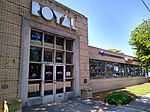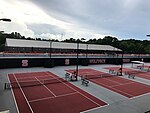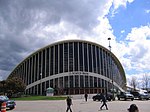Method Road Soccer Stadium
1984 establishments in North CarolinaCollege lacrosse venues in the United StatesCollege soccer venues in the United StatesLacrosse venues in North CarolinaNC State Wolfpack sports venues ... and 6 more
North Carolina State UniversityNorth Carolina sports venue stubsRaleigh, North Carolina building and structure stubsSoccer venues in North CarolinaSports venues completed in 1984Sports venues in Raleigh, North Carolina

Method Road Soccer Stadium (usually called Method Road) was the on campus soccer stadium at North Carolina State University in Raleigh, North Carolina. The stadium was opened in the summer of 1984.Method Road held 3,000 spectators before the bleachers were removed following the construction of Dail Soccer Field. The playing field has been retained for student use. Method Road also hosts the Wolfpack club lacrosse team that competes in the Men's Collegiate Lacrosse Association.
Excerpt from the Wikipedia article Method Road Soccer Stadium (License: CC BY-SA 3.0, Authors, Images).Method Road Soccer Stadium
Method Road, Raleigh Method
Geographical coordinates (GPS) Address Nearby Places Show on map
Geographical coordinates (GPS)
| Latitude | Longitude |
|---|---|
| N 35.788363888889 ° | E -78.692969444444 ° |
Address
Method Soccer Field
Method Road
27606 Raleigh, Method
North Carolina, United States
Open on Google Maps







